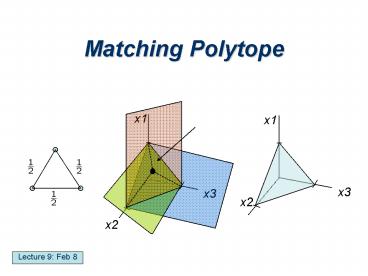Matching Polytope - PowerPoint PPT Presentation
1 / 26
Title:
Matching Polytope
Description:
Matching Polytope. Goal: Optimize ... Good relaxation: every vertex of the polytope is integral ... So every fractional solution is in the matching polytope. ... – PowerPoint PPT presentation
Number of Views:45
Avg rating:3.0/5.0
Title: Matching Polytope
1
Matching Polytope
- Lecture 9 Feb 8
2
Good Relaxation
Every vertex could be the unique optimal
solution for some objective function.
So, we need every vertex to be integral.
For every objective function, there is a vertex
achieving optimal value.
So, it suffices if every vertex is integral.
Goal Every vertex is integral!
3
Basic Solution
Tight inequalities inequalities achieved as
equalities
Basic solution unique solution of n linearly
independent tight inequalities
Think of 3D.
4
Matching Polytope
Goal Optimize over matchings.
A geometric approach think of matchings as high
dimensional points
Linear programming use hyperplanes (linear
inequalities)
to define the solution space
Good relaxation every vertex of the polytope is
integral
Prove every basic solution is integral
5
Matching Polytope
Matching polytope
Linear program
Convex hull of matchings
Intersections of hyperplanes
Define by points
Define by inequalities
P
Q
Goal Prove they are equal
6
Matching Polytope
Prove P is smaller than Q, and Q is smaller than
P.
Easy direction Check all points of P (i.e. all
matchings) satisfy all the inequalities
Another direction Check all points of Q (i.e.
all fractional solutions) is inside P.
How?
By showing that all points are convex combination
of vertices of P
7
Maximum Bipartite Matchings
Bipartite perfect matching, 2n vertices.
Goal show that any fractional solution is a
convex combination of matchings
Consider a minimal counterexample, i.e. a
smallest graph for which there is a fractional
solution that is not a convex combination of
matchings.
8
Convex Combination of Matchings
0.25
0.65
0.25
0.35
0.35
0.75
0.4
0.4
0.35
0.25
9
Maximum Bipartite Matchings
An edge of 0, delete it.
An edge of 1, reduce it.
10
Convex Combination of Matchings
0.25
0.65
0.25
0.35
1
0.35
0.75
0.4
0.4
0.35
0.25
0.4
0.25
0.35
11
Maximum Bipartite Matchings
An edge of 0, delete it.
An edge of 1, reduce it.
So, each vertex has degree 2, and there are at
least 2n edges.
12
Maximum Bipartite Matchings
An edge of 0, delete it.
An edge of 1, reduce it.
So, each vertex has degree 2, and there are at
least 2n edges.
How many tight inequalities?
Exactly 2n
How many linearly independent tight inequalities?
At most 2n-1
13
Linear Dependency
x3
x2
x1
x4
Multiply 1
Each edge counts twice, one positive, one
negative.
Multiply -1
Sum up to 0 gt linear dependency.
14
Maximum Bipartite Matchings
An edge of 0, delete it.
An edge of 1, reduce it.
So, each vertex has degree 2, and there are at
least 2n edges.
How many tight inequalities?
Exactly 2n
How many linearly independent tight inequalities?
At most 2n-1
Basic solution unique solution of 2n linearly
independent tight inequalities
CONTRA!
15
Maximum Bipartite Matchings
An edge of 0, delete it.
An edge of 1, reduce it.
Conclusion A basic solution must have an edge of
0 or an edge of 1. In either case, we can show
by induction that a fractional solution is a
convex combination of matchings.
16
Maximum General Matchings
When does the proof breaks down for general
graphs?
How many linearly independent tight inequalities?
At most 2n-1
And so we cannot say a basic solution must
contain an edge of 0 or an edge of 1.
17
Valid Inequalities
Odd set inequalities
Thats enough.
Edmonds 1965
18
Maximum General Matchings
An edge of 0, delete it.
An edge of 1, reduce it.
For every odd set S
19
Maximum General Matchings
An edge of 0, delete it.
An edge of 1, reduce it.
Tight odd-set, contract it.
20
Maximum General Matchings
0.3
Fractional solutions satisfying inequalities
0.7
0.3
0.3
Check degree
0.7
0.7
Check odd-set
By induction, each smaller fractional solution
is a convex combination of matchings
21
Maximum General Matchings
0.3
0.7
0.7
Fractional solutions satisfying inequalities
0.3
0.3
0.7
0.3
0.3
0.7
0.7
Check degree
0.3
0.3
0.7
0.7
Check odd-set
By induction, each smaller fractional solution
is a convex combination of matchings
22
Maximum General Matchings
0.3
0.7
0.7
Fractional solutions Satisfying inequalities
0.3
0.3
0.7
0.3
0.3
0.7
0.7
Check degree
0.3
0.3
0.7
0.7
Check odd-set
By induction, each smaller fractional solution
is a convex combination of matchings
So is the original fractional solution!
DONE!
23
Maximum General Matchings
An edge of 0, delete it.
An edge of 1, reduce it.
Tight odd-set, contract it.
At most 2n tight (degree) tight constraints!
Since each vertex has degree 2, there are at
least 2n edges.
24
Maximum General Matchings
At most 2n tight (degree) tight constraints!
Since each vertex has degree 2, there are at
least 2n edges.
Basic Solution 2n tight linearly independent
contraints for 2n dimensions
- So, exactly 2n edges.
- Since each vertex has degree 2, the edges form
disjoint union of cycles. - No odd cycle because of the odd-set constraints,
so only even cycles. - Even cycle can be decomposed into matchings.
- Therefore, a convex combination of matchings.
25
Maximum General Matchings
So every fractional solution is a convex
combination of matchings
So every fractional solution is in the matching
polytope.
This means that the inequalities define exactly
the polytope.
26
Different Approaches
Combinatorial algorithms
Linear programming
Graph theoretical approach
Geometric approach
Design and analysis of algorithms
Design and analysis of linear inequalities
Less intuitive
More intuitive
More powerful
Less powerful































